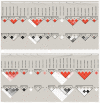Evaluation of common genetic variants in 82 candidate genes as risk factors for neural tube defects
- PMID: 22856873
- PMCID: PMC3458983
- DOI: 10.1186/1471-2350-13-62
Evaluation of common genetic variants in 82 candidate genes as risk factors for neural tube defects
Abstract
Background: Neural tube defects (NTDs) are common birth defects (~1 in 1000 pregnancies in the US and Europe) that have complex origins, including environmental and genetic factors. A low level of maternal folate is one well-established risk factor, with maternal periconceptional folic acid supplementation reducing the occurrence of NTD pregnancies by 50-70%. Gene variants in the folate metabolic pathway (e.g., MTHFR rs1801133 (677 C > T) and MTHFD1 rs2236225 (R653Q)) have been found to increase NTD risk. We hypothesized that variants in additional folate/B12 pathway genes contribute to NTD risk.
Methods: A tagSNP approach was used to screen common variation in 82 candidate genes selected from the folate/B12 pathway and NTD mouse models. We initially genotyped polymorphisms in 320 Irish triads (NTD cases and their parents), including 301 cases and 341 Irish controls to perform case-control and family based association tests. Significantly associated polymorphisms were genotyped in a secondary set of 250 families that included 229 cases and 658 controls. The combined results for 1441 SNPs were used in a joint analysis to test for case and maternal effects.
Results: Nearly 70 SNPs in 30 genes were found to be associated with NTDs at the p < 0.01 level. The ten strongest association signals (p-value range: 0.0003-0.0023) were found in nine genes (MFTC, CDKN2A, ADA, PEMT, CUBN, GART, DNMT3A, MTHFD1 and T (Brachyury)) and included the known NTD risk factor MTHFD1 R653Q (rs2236225). The single strongest signal was observed in a new candidate, MFTC rs17803441 (OR = 1.61 [1.23-2.08], p = 0.0003 for the minor allele). Though nominally significant, these associations did not remain significant after correction for multiple hypothesis testing.
Conclusions: To our knowledge, with respect to sample size and scope of evaluation of candidate polymorphisms, this is the largest NTD genetic association study reported to date. The scale of the study and the stringency of correction are likely to have contributed to real associations failing to survive correction. We have produced a ranked list of variants with the strongest association signals. Variants in the highest rank of associations are likely to include true associations and should be high priority candidates for further study of NTD risk.
Figures


Similar articles
-
Association between MTHFD1 polymorphisms and neural tube defect susceptibility.J Neurol Sci. 2015 Jan 15;348(1-2):188-94. doi: 10.1016/j.jns.2014.12.001. Epub 2014 Dec 6. J Neurol Sci. 2015. PMID: 25524527
-
Replication and exploratory analysis of 24 candidate risk polymorphisms for neural tube defects.BMC Med Genet. 2014 Oct 8;15:102. doi: 10.1186/s12881-014-0102-9. BMC Med Genet. 2014. PMID: 25293959 Free PMC article.
-
Association of main folate metabolic pathway gene polymorphisms with neural tube defects in Han population of Northern China.Childs Nerv Syst. 2018 Apr;34(4):725-729. doi: 10.1007/s00381-018-3730-0. Epub 2018 Feb 1. Childs Nerv Syst. 2018. PMID: 29392422
-
The role of Vitamin B12 and genetic risk factors in the etiology of neural tube defects: A systematic review.Int J Dev Neurosci. 2021 Aug;81(5):386-406. doi: 10.1002/jdn.10113. Epub 2021 Apr 22. Int J Dev Neurosci. 2021. PMID: 33851436
-
Insights into prevention of human neural tube defects by folic acid arising from consideration of mouse mutants.Birth Defects Res A Clin Mol Teratol. 2009 Apr;85(4):331-9. doi: 10.1002/bdra.20552. Birth Defects Res A Clin Mol Teratol. 2009. PMID: 19117321 Review.
Cited by
-
Unveiling the Therapeutic Potential of Folate-Dependent One-Carbon Metabolism in Cancer and Neurodegeneration.Int J Mol Sci. 2024 Aug 28;25(17):9339. doi: 10.3390/ijms25179339. Int J Mol Sci. 2024. PMID: 39273288 Free PMC article. Review.
-
Genetic polymorphisms and folate status.Congenit Anom (Kyoto). 2017 Sep;57(5):142-149. doi: 10.1111/cga.12232. Epub 2017 Jul 20. Congenit Anom (Kyoto). 2017. PMID: 28598562 Free PMC article. Review.
-
Folate-related gene variants in Irish families affected by neural tube defects.Front Genet. 2013 Nov 6;4:223. doi: 10.3389/fgene.2013.00223. eCollection 2013. Front Genet. 2013. PMID: 24223580 Free PMC article.
-
One-carbon metabolism and folate transporter genes: Do they factor prominently in the genetic etiology of neural tube defects?Biochimie. 2020 Jun;173:27-32. doi: 10.1016/j.biochi.2020.02.005. Epub 2020 Feb 13. Biochimie. 2020. PMID: 32061804 Free PMC article. Review.
-
Nutrition, One-Carbon Metabolism and Neural Tube Defects: A Review.Nutrients. 2016 Nov 23;8(11):741. doi: 10.3390/nu8110741. Nutrients. 2016. PMID: 27886045 Free PMC article. Review.
References
-
- Congenital malformations worldwide. A report from the International Clearinghouse for Birth Defects Monitoring Systems. Amsterdam, Elsevier Science Publishers; 1991.
-
- Canfield MA, Honein MA, Yuskiv N, Xing J, Mai CT, Collins JS, Devine O, Petrini J, Ramadhani TA, Hobbs CA. et al.National estimates and race/ethnic-specific variation of selected birth defects in the United States, 1999–2001. Birth Defects Res A Clin Mol Teratol. 2006;76(11):747–756. doi: 10.1002/bdra.20294. - DOI - PubMed
-
- Botto LD, Lisi A, Robert-Gnansia E, Erickson JD, Vollset SE, Mastroiacovo P, Botting B, Cocchi G, de Vigan C, de Walle H. et al.International retrospective cohort study of neural tube defects in relation to folic acid recommendations: are the recommendations working? BMJ. 2005;330(7491):571. doi: 10.1136/bmj.38336.664352.82. - DOI - PMC - PubMed
Publication types
MeSH terms
Substances
Grants and funding
LinkOut - more resources
Full Text Sources
Medical
Research Materials
Miscellaneous

